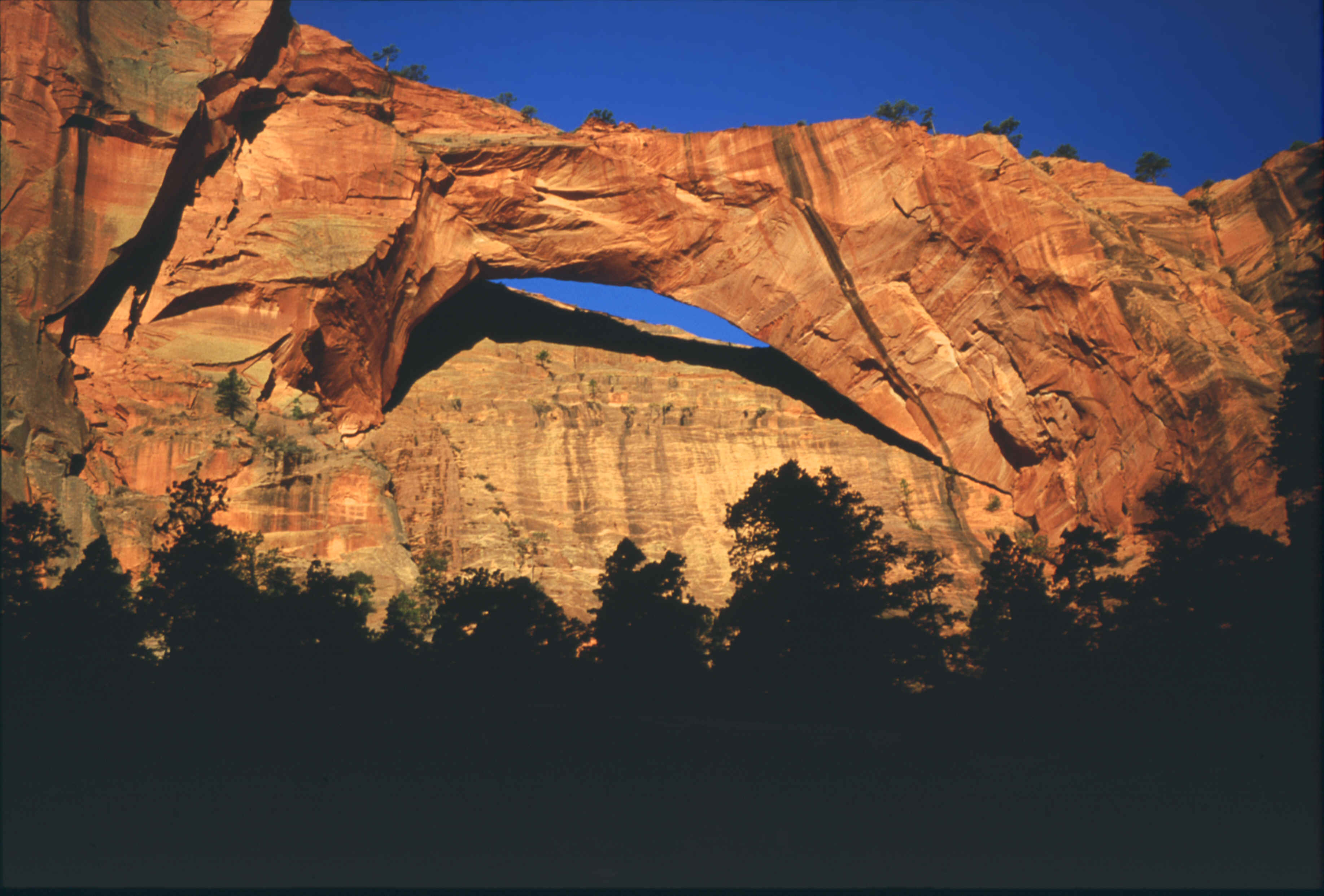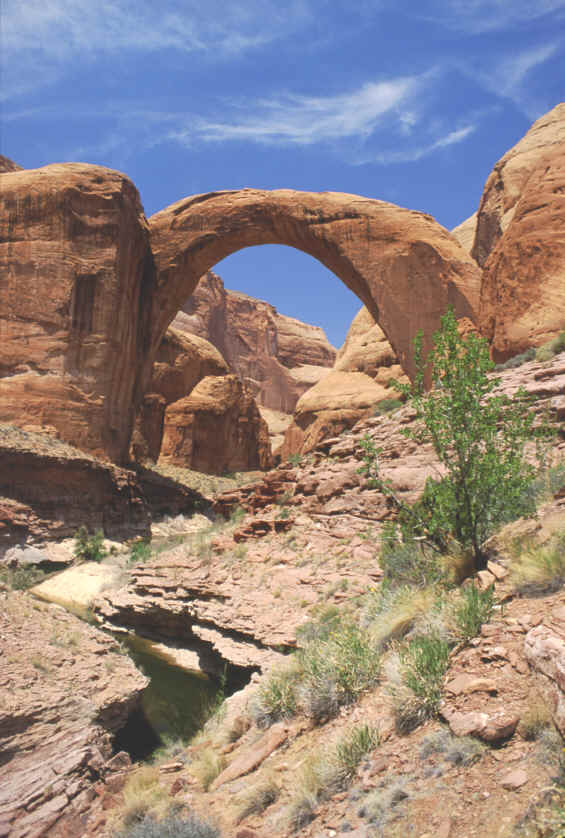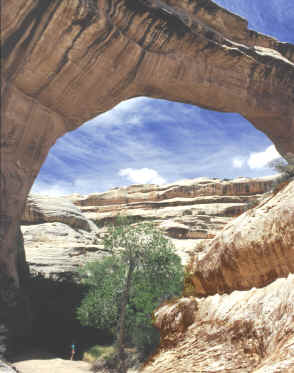
Kolob Arch, Zion National Park, Utah

I had never been much of a hiker at all. In fact, I well remembered thinking a few years earlier that a certain girl was quite crazy when she told me she loved nothing better than backpacking in the desert for days on end. It seemed like an awful punishment for nothing, to me. But here I was, getting ready to go on the 14-mile hike through the Kolob Canyons necessary to see this great arch. I had borrowed an old backpack from a friend, which taught me then and forever the value of buying only the best form-fitted one available, because a wretched pack can ruin your trip about as surely as a broken bone, and hurt about as much. I had a nice new tent, and I had just bought a new sleeping bag in a town nearby, which claimed to be adequate down to 21 degrees F. That spring night was nowhere near that temperature, but I spent one of the most miserable, huddled-up nights of a lifetime out there. But before that, as the last red light was fading from the giant arch, I found myself thinking, "Six billion people on this planet -- why am I the only one on earth spending the night below the world’s greatest arch?" But I was glad our country can still offer a nature experience like that, a majestic scene, totally unpeopled.
As for getting up on top, hah! -- good luck. There was no way up those cliff walls. I have heard since that a tiny handful of people have managed to come up on the mesa from far behind, using a long and difficult unmarked route, to eventually reach the arch. But from the top, you really wouldn’t be able to see it. I was glad for my view. It was even more awesome than I had expected. It faced a beautiful deep canyon, so wild I had to search an hour for a spot even flat enough for my little tent. I knew the full sun only hit the arch early in the morning, and that was the best picture-taking time, which was why I was spending the night there. I got up at dawn, too frozen to stay inactive any longer. The arch was glowing gold and orange far above, and the show was all just for me.
The trek back out taught me the truth about canyon hiking, as opposed to mountain climbing. The hard part is at the end, when you are already dead tired! Those last few thousand weary steps out of the canyon seem straight up, before you finally reach the road on the rim.
I took the sleeping bag back to the store to trade it in for
a warmer model. "We can’t take it back if you’ve already slept in
it." "I didn’t," I told them. And that was true.
 The world’s largest natural bridge (and the third largest
span overall, at 275 feet wide) is the famous Rainbow Bridge on Lake Powell,
Utah. It is a protected National Monument, with no climbing on it allowed, for
good reason -- it gets hordes of visitors all year long, and somebody would be
sure to have an accident. Once long ago it required a fifty-mile round-trip hike
or horse ride to see it, but since the formation of the huge reservoir, a
pleasant 2 or 3 hour boat ride will get you there, no sweat. But the wilderness
experience has been destroyed by the supposedly necessary garbage cans,
restrooms, guard rails, walk ramps, picnic tables and warning signs; and the
ease of getting there, plus the gaping throngs, seem to diminish the impact of
the beautiful bridge -- quite the contrary of the equally grandiose Kolob arch.
It is truly a world-class wonder though, and is even taller (290 feet) than it
is wide; but I knew it wouldn’t provide what I was looking for, so it would be
several years before I finally went to visit the great Nonnezoshie, the Rainbow
Bridge.
The world’s largest natural bridge (and the third largest
span overall, at 275 feet wide) is the famous Rainbow Bridge on Lake Powell,
Utah. It is a protected National Monument, with no climbing on it allowed, for
good reason -- it gets hordes of visitors all year long, and somebody would be
sure to have an accident. Once long ago it required a fifty-mile round-trip hike
or horse ride to see it, but since the formation of the huge reservoir, a
pleasant 2 or 3 hour boat ride will get you there, no sweat. But the wilderness
experience has been destroyed by the supposedly necessary garbage cans,
restrooms, guard rails, walk ramps, picnic tables and warning signs; and the
ease of getting there, plus the gaping throngs, seem to diminish the impact of
the beautiful bridge -- quite the contrary of the equally grandiose Kolob arch.
It is truly a world-class wonder though, and is even taller (290 feet) than it
is wide; but I knew it wouldn’t provide what I was looking for, so it would be
several years before I finally went to visit the great Nonnezoshie, the Rainbow
Bridge.
Three more giant bridges stand along a river in Utah, in the Natural Bridges National Monument. That three such huge, and very different, bridges could have formed so close together, with no others in the area even coming close in size, was an intriguing and incredible fact of nature that I decided I would just have to inspect, though I knew there would be no climbing allowed there either. All three can be seen on a moderate hike of six or seven hours, through a lovely green river bottom with cottonwood trees and Anasazi ruins.
The Sipapu Bridge (below) is the fourth largest natural span in the world, and the second largest natural bridge. It has one of the most perfect and symmetrical shapes of any I’ve seen -- it’s really bridge-like, flat on top and rounded beneath. It used to be called the Augusta Bridge, and I wish it still was -- it’s the perfect name for such an august, inspiring structure. I could see it up ahead as I was hiking toward it, but then suddenly, after making a climb down plus a few turns on the trail, I lost it completely. Looking all around, confused, I was amazed that such a major piece of rock could just disappear. Then I looked overhead -- and 220 feet straight above me, there it soared.
 Three miles upstream, astride the same river stands the
Kachina Bridge (at 206 feet the #3 bridge and #8 span overall). Whereas the
Sipapu is majestic, imposing, serene, even sublime -- its sister the Kachina
is massive, cavernous, hulking, and truly scary to walk beneath. 4000 tons of
rock, which fell in 1994, litter the ground beneath it, plus plenty of older
rockfall. This is a "young" bridge, still very much in a growing mode;
no great beauty now, it has all the potential in the world, many lifetimes from
now, to be the biggest on the list.
Three miles upstream, astride the same river stands the
Kachina Bridge (at 206 feet the #3 bridge and #8 span overall). Whereas the
Sipapu is majestic, imposing, serene, even sublime -- its sister the Kachina
is massive, cavernous, hulking, and truly scary to walk beneath. 4000 tons of
rock, which fell in 1994, litter the ground beneath it, plus plenty of older
rockfall. This is a "young" bridge, still very much in a growing mode;
no great beauty now, it has all the potential in the world, many lifetimes from
now, to be the biggest on the list.
After a bit of a climb and 3 more miles upstream, the wonderful Owachomo comes into view. At 180 feet, it’s not one of the Big Nine, but it’s the favorite of many who visit here. It’s a fragile span, ancient before the Kachina was ever born. Even the sidestream that formed it changed its course long ago, and then disappeared, making this a bridge now with no water below it. A century ago, cowboys dared each other to ride their horses across its narrow length. I would love to walk it myself, but the rules are there for good reason.
While talking to a park ranger, I found out I wasn’t the only arch nut around. In fact, he said there was a small convention of arch lovers going on that same weekend in Moab, Utah. I drove there immediately, and arrived just in time for the last meeting. So I joined the Natural Arch and Bridge Society, and was amazed to find out that the president of the organization lived on the same street I live on in Oklahoma City, about a block away. And we were the only two members in Oklahoma.
Now a whole new world was open. I could get pictures and accurate directions for dozens of fabulous arches and bridges I’d never even heard of before -- none on the scale of the Big Nine, of course, but I was finding out about lots more places I really just had to go see now; the most beautiful or unusual arches are not necessarily the largest.
The next day, I took an easy hike out to the Morning Glory Arch, ranked #6 in the world. No pictures I had seen of it ever seemed to make much sense; they were all at some awkward angle and looked distinctly unimpressive. I found out why. Though the arch is undeniably huge, and quite impressive "in person", it suffers from its location. It is sandwiched longways in between two tall cliff walls, only separated from the wall behind it by a few feet, getting little sunshine on it. Even with a wide angle lens, you can’t back up far enough to get the whole 243-foot length in a camera’s view. It is a quiet and pretty spot, though, just a little ways outside the boundaries of Arches National Park, and therefore unprotected. But I found no way to get on top of it unassisted, though the arch is at such an amazingly flat angle it would probably be a simple stroll on across once I was up there. Its flatness is perhaps the most remarkable thing about the arch -- there’s very little arch or height to it, though it has great length and mass. You wonder how it can support is own great weight.
It was here, at the Morning Glory, that I suddenly had a bit of a stomach problem. I had always heard, that if you're out in the wilds and you have to "go", to use some big leaves as toilet paper. So I picked the biggest ones I could find, which worked reasonably well. Later, as I was continuing down the trail, a nice old lady passing by pointed out the same kind of plants to me, and warned me, "Watch out for all that poison ivy!"
Though well worth the four-mile hike to visit it, and quite unique in is own way, unfortunately the Morning Glory Arch is probably nobody’s favorite.